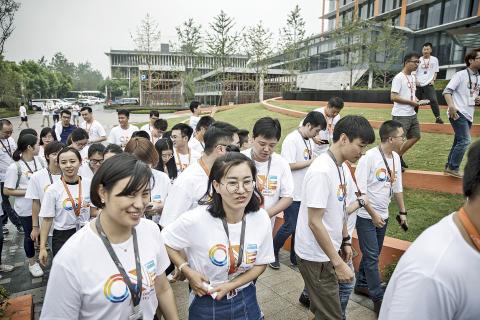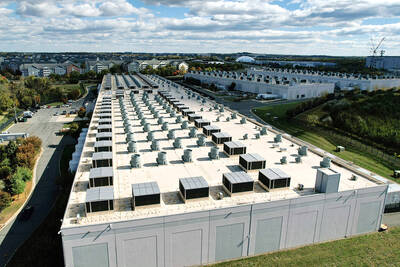China’s war for technology talent is intensifying. Tens of thousands of people are being hired to shore up cybersecurity, help censor online content and try to make China No. 1 in the application of artificial intelligence (AI), as capital pours into both start-ups and more mature businesses at a time when the Chinese government is demanding rapid development.
“Companies are well-funded and are in serious competition for talent,” said Thomas Liang (梁培華), a former executive at Chinese search giant Baidu Inc (百度) who is now running an AI-focused fund.
He said that start-ups in hot sectors like AI often have to offer 50 to 100 percent pay raises to attract employees away from established technology firms.

Photo: Bloomberg
China’s emergence as a global center for technology, with champions such as Alibaba Group Holding Ltd (阿里巴巴) and Tencent Holdings Ltd (騰訊) now worth more than US$1 trillion combined, has led to a hiring boom and wage growth that starts to put top salaries within striking distance of those offered in Silicon Valley.
While that should please the Chinese government, as it seeks to create higher-paying jobs and move up the value chain, it could also add to income inequality in China as wages in non-tech jobs lag, and as the sector’s recruitment and income gains tend to be concentrated in the biggest cities such as Beijing and Shenzhen.
Technology is certainly a major driver of growth in China. Output in China’s information technology and software sector expanded by 33.8 percent year-on-year in the fourth quarter of last year, compared with 29 percent growth in the third quarter, according to data from the statistics bureau.
In China, top graduates working on AI can command salaries of 300,000 yuan to 600,000 yuan (US$47,066 to US$94,132) a year, according to tech recruitment Web site 100offer.com, while team leaders with three to five years of experience can make more than 1.5 million yuan annually. Many of these jobs are in Beijing or Shenzhen.
Liang said salaries in the industry have roughly doubled since 2014.
By comparison, an AI researcher in San Francisco makes an average of US$112,659 a year, and a machine learning engineer in the same city an average US$150,815, according to job search site Indeed.com.
For Chinese software engineers who have studied in the US, but worry about the effects of US President Donald Trump’s immigration policies on their chances of retaining visas, returning home is becoming more appealing.
Chinese tech firms have said that they actively recruit Chinese students from US colleges and many have opened offices in Silicon Valley to attract top talent.
The boom in AI work is prompting some engineers to retrain in China.
“I doubled my salary by making the AI jump,” said Song, a 26-year-old AI engineer in Beijing who makes about US$55,000 per year after taking AI training courses in his own time.
As a 26-year-old AI engineer working for Beijing ByteDance Technology Co (北京字節跳動科技), maker of the Chinese news aggregator app Toutiao (今日頭條), George is pulling down an annual salary of about US$60,000, but said that he might jump ship if something better comes along.
Both Song and George asked that their full names not be used.
The money is still pouring in. More than US$65 billion of venture capital investments were made in Greater China last year, up 35 percent from a year earlier, according to research firm Preqin Ltd, an all-time high and second only to North America, with US$77 billion.
Chinese President Xi Jinping (習近平) told the Chinese Communist Party Congress held last year that China will push for the integration of the Internet, big data and AI with the traditional economy.
This is all part of a government drive to move the Chinese economy up the value chain with a particular emphasis on areas such as information technology, robotics and energy-saving vehicles.
The Chinese government is also behind a massive push to use facial recognition and other technologies to track people on a national scale — the authorities have said that it will improve security and reduce crime, while human rights advocates said it is part of a giant surveillance state and will be used against activists and dissidents.
Among the fastest-growing tech companies is Beijing-based AI start-up Cloudminds (達闥科技公司). It plans to expand headcount by almost 40 percent this year from 400, human resources director Arina Li told reporters.
The technology hiring and wage rises are starting to show up in the wider economy.
After stagnating for several years, disposable income growth in China last year accelerated to 7.3 percent, according to official data published last week.
However, the gains are much greater for those in the country’s burgeoning tech hubs — Beijing, Shenzhen, Shanghai and Hangzhou — where the disparity with average salaries mirrors trends seen in San Francisco.
However, it is not all roses in China’s labor market, as high-paying tech jobs are only available to a tiny slice of the overall workforce, and even official surveys show declining employment in both the manufacturing and services industries.
The high salaries in the tech industry far outpace typical income levels in China, where average per capita disposable income was just 25,974 yuan last year, China’s statistics bureau said last week.
“Don’t forget that in 2018, [China] is going to have 8.2 million fresh university graduates. Those guys need a job. So from my point of view the pressure to create enough jobs is still there,” said Qu Hongbin (屈宏斌), Greater China chief economist at HSBC in Hong Kong.

The demise of the coal industry left the US’ Appalachian region in tatters, with lost jobs, spoiled water and countless kilometers of abandoned underground mines. Now entrepreneurs are eyeing the rural region with ambitious visions to rebuild its economy by converting old mines into solar power systems and data centers that could help fuel the increasing power demands of the artificial intelligence (AI) boom. One such project is underway by a non-profit team calling itself Energy DELTA (Discovery, Education, Learning and Technology Accelerator) Lab, which is looking to develop energy sources on about 26,305 hectares of old coal land in

Taiwan’s exports soared 56 percent year-on-year to an all-time high of US$64.05 billion last month, propelled by surging global demand for artificial intelligence (AI), high-performance computing and cloud service infrastructure, the Ministry of Finance said yesterday. Department of Statistics Director-General Beatrice Tsai (蔡美娜) called the figure an unexpected upside surprise, citing a wave of technology orders from overseas customers alongside the usual year-end shopping season for technology products. Growth is likely to remain strong this month, she said, projecting a 40 percent to 45 percent expansion on an annual basis. The outperformance could prompt the Directorate-General of Budget, Accounting and

Netflix on Friday faced fierce criticism over its blockbuster deal to acquire Warner Bros Discovery. The streaming giant is already viewed as a pariah in some Hollywood circles, largely due to its reluctance to release content in theaters and its disruption of traditional industry practices. As Netflix emerged as the likely winning bidder for Warner Bros — the studio behind Casablanca, the Harry Potter movies and Friends — Hollywood’s elite launched an aggressive campaign against the acquisition. Titanic director James Cameron called the buyout a “disaster,” while a group of prominent producers are lobbying US Congress to oppose the deal,

Two Chinese chipmakers are attracting strong retail investor demand, buoyed by industry peer Moore Threads Technology Co’s (摩爾線程) stellar debut. The retail portion of MetaX Integrated Circuits (Shanghai) Co’s (上海沐曦) upcoming initial public offering (IPO) was 2,986 times oversubscribed on Friday, according to a filing. Meanwhile, Beijing Onmicro Electronics Co (北京昂瑞微), which makes radio frequency chips, was 2,899 times oversubscribed on Friday, its filing showed. The bids coincided with Moore Threads’ trading debut, which surged 425 percent on Friday after raising 8 billion yuan (US$1.13 billion) on bets that the company could emerge as a viable local competitor to Nvidia